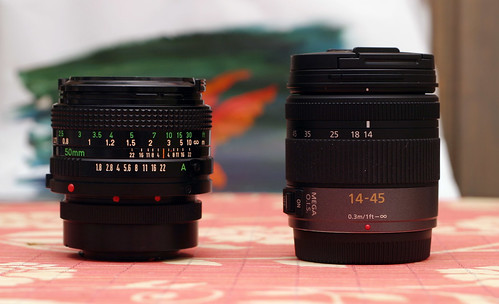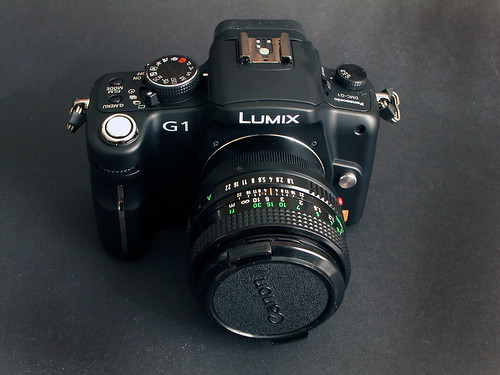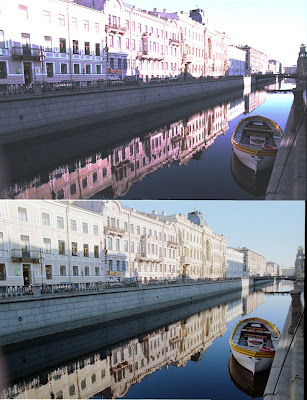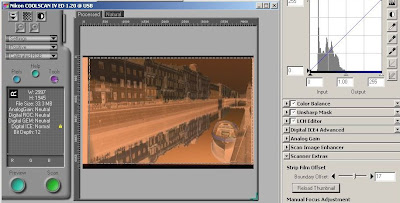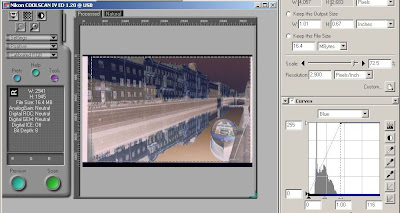In communication with the fellow who manufacturers the FD series Adaptor I am using for my G1 he reports that some users have said that focus is perfect, others have said focus is past infinity and still others experience not being able to get infinity. Applying f8 seems to clear this up to become non existent an issue.
It is sort of a non-issue, but as there has been some discussion on this issue (including some customer queries for the adapter maker) I thought I would put up this page in case it helps clear anyhing up for anyone else (and essentially I was curious too).
I have a couple of working theories on this but I think that the evidence points to one of them more strongly. Here are my theories
My theory ... aahem (is not about dinosaurs)
The Lens tolerance theory:
Fundamentally this goes on the lines that lenses were not properly 'set' to have their infinity stop critically perfect.
The lenses being adapted were designed to work with 35mm film cameras (well, mainly as people are adapting all manner of lenses). Given that in the pre-1980's it was rare and even a little exotic to enlarge 35mm film images much more than x10 (giving a 36 x 24 cm print assuming no cropping). Add to this that:
- few enlargements were made with the best possible optics
- super critical folks used Medium Format or larger which gave better results
- focus was typically on people slightly foreground of infinity (so why not bias it there?)
- only astrophotographers were interested in infinity focus (and they didn't use 50mm lenses and hand calibrated what they had on their ground glass with microscopes anyway)
- people may have been less critical
As I said in an earlier post to put a perspective on it if this sort of image density was being pulled from a piece of 35mm film, it would be similar to a 4600dpi scan (since the image density is about 182 pixels per mm).
Added to this is the point that if you focus slightly 'past' infinity (bring the lens a little too close) absolutely nothing in the picture will be clearly focused. Now if I was a camera maker the last thing I'd want to happen in my cost cutting production exersizes is to make my company lenses look less than perfect. So I'd bias my 'near enough' settings on my cheaper lenses to be erring on the better side.
The Camera tolerance theory:
Panasonic makes the G1 to work with electronically activated lenses. Even "manual focus" is acheived by electronic movement of the lens in responce to moving a 'focus ring' at the front of the lens body. As such there is no need for any mechanical optical precision as in the days of Leica coupled range finder mechanisms. This would vastly simplify construction and reduce costs with tolerances around 0.2mm being quite acceptable in terms of the placement of the CCD (and which would not be tolerable in a mechano-optically orinted system).
Evidence:
I happen to have 2 50mm lenses: a New FD 50mm f1.8 and an EF 50 f1.8 series one lens. These lenses are (as far as I know) the same optical design and only placed in different housings. So, to aquire some information to examine my theory I put the EF on my 10D and the FD onto my G1 and took some images from my balcony. I set both lenses at f1.8 to exaggerate the effects of focus by minimizing the depth of field. Shutter speed at ISO 100 was 4000th of a second and camera was mounted on a tripod for both shots.
Both images were taken with the camera set to record as RAW and converted using dcraw with the command parameters of: dcraw -4 -T -f
 This should equalise as many things as possible. Clearly one issue is that the differing sensor sizes will make clear comparisons more problematic, but as you'll see I have some strategy for that.
This should equalise as many things as possible. Clearly one issue is that the differing sensor sizes will make clear comparisons more problematic, but as you'll see I have some strategy for that.Just as a reminder the diagram to the left gives a scale representation of the physical size difference between APS (22.7x15.1mm) and Four Thirds (18x13.5mm). Its close on the verticle axis but less wide.
My view of this is that neither is a match for 35mm (considerably larger again) but if we take a 100% sample from the middle (for example say a 5mm square area) then we can compare each to see if the focus is different there.
Firstly here's an overview of the image as taken by each camera.

I've tried to focus on the same location in the middle floor on the right hand side. Ther eis a flagpole about 10 meters away, and a birch tree about 20 meters. The building is about 100 meters and the forest in the distance is about 400 or so meters.
First I thought I would scale down the G1 image to be the same sensor resolution as the 10D. So I took the image and resized it to 2488 pixels wide (this is what the dimensions of a similar sized four thirds 'cut' from a larger APS sensor would be). This is then shown at 100% view and a screen snapshot taken.
 If you click on the image (or any of the following ones) it will load a full sized version to make it clearer to examine. While both images look pretty grubby (with the FD 50 on the G1 seeming to be a little sharper) it seems that neither are focused on Infinity. Its a hard call with the 10D image though as its muddy enough all the way back there to make it difficult to say.
If you click on the image (or any of the following ones) it will load a full sized version to make it clearer to examine. While both images look pretty grubby (with the FD 50 on the G1 seeming to be a little sharper) it seems that neither are focused on Infinity. Its a hard call with the 10D image though as its muddy enough all the way back there to make it difficult to say.Moving over to the left where you can see the forest perhaps makes it easier to call:

There might be more detail over there in the forest in the 10D (lower) but heck not really. Now (for something different) I'd like to present the non scaled version of the images. This is from the central portion of the image and 100% view for each G1 and 10D

Its here that we see that focus on the G1 adapted lens really is better at the birch tree and contains substantially more information than the one on the 10D.
Keep in mind, these are more or less the same optical lens (of course different examples) but short of making an EF mount adaptor and putting the EF lens onto the G1 this is as close as it gets (because FD lenses will not focus to infinity on EF mounts without an optical adapter which will effect sharpness).
Looking at the corner from above with the G1 at 100% gives this:
 to me it shows that its not focused on the background on either (but the 10D is really too mushy to be able to go out on a limb on this one).
to me it shows that its not focused on the background on either (but the 10D is really too mushy to be able to go out on a limb on this one).So with my evidence (two lenses, one adaptor one G1) it could easily be the Lens tolerance theory that is perhaps the right one, but more testing with other cameras would be needed to be sure. Given that ciecio7 has reported that his customers have discovered all three situations (right on, behind infinity, before infinity) it could easily be the Camera tolerance one.
Me? I'm leaning to the Lens tolerance theory, as my FD 300 has a "zone" of infinity which it will go past. Some of my EF zooms (my 28-105 comes to mind) had exactly this also built into the design (discussions in rec.photo at the time suggested it was to account for temperature causing variablity expansion of the plastic parts).
What would I prefer to do?
well given that I can't easilly adjust my lenses for infinity focus I'd rather have the adaptors set to allow focus slightly past infinity. Sure it would mean that 'bang the ring around' set infinity focus by feel would be out of the question but we do have good focus confirmation on our G1's.
Its a hard call though cos sometimes I'll take images in the near total dark and being able to set focus this way with wide angle lenses is handy (and you can point the camera more or less in the right direction anyway. Images like the one below was taken with manual focus and I just couldn't see a bloody thing in the view finder. It was a dark Finnish winter evening with the glow of a town in the overcast sky in the distance. Exposure time was 60 seconds.

so its a hard as if I had to bring forward a little from Infinity I might forget to do it.
Perhaps the "lens tolerance" design theory is right ... and its by design (those cunning engineers in at Canon) after all?
I have a solution to this particular problem here
